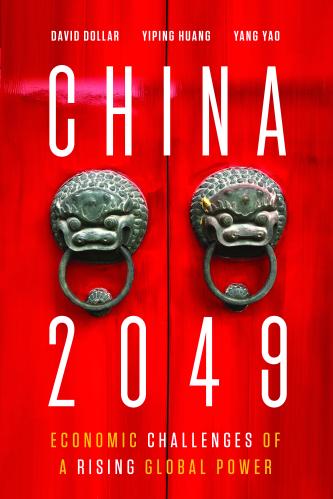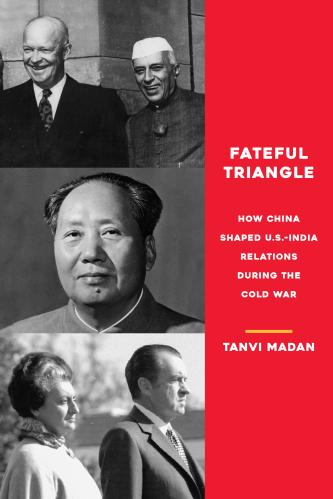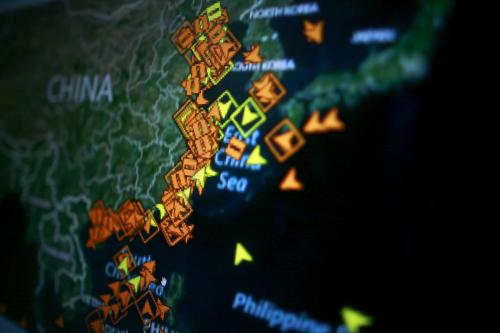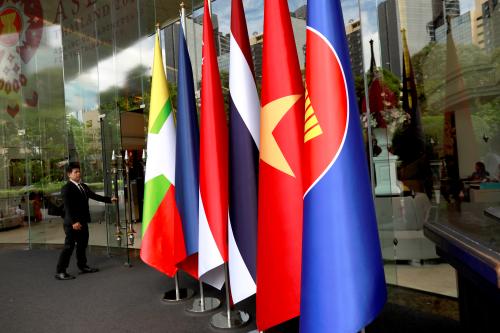This piece is the second in a two-part series by David M. Rubenstein Fellow Lindsey Ford discussing the dominant China debates in U.S. policy circles today. Read the accompanying piece here.
Looking back on the most prominent China debates of 2019, it’s clear that we need to refocus the discussion about “strategic competition” for 2020. The center of gravity in U.S. policy debates needs to shift away from Beijing and toward the challenging policy choices needed to better adapt the U.S. alliance network to manage China’s rise.
In an accompanying piece, I explore allied anxieties about “choosing” between Washington and Beijing, as well as how to manage fears about a U.S.-China decoupling. Here, I discuss how to reframe ongoing debates about U.S. grand strategy and ideological competition.
Beijing’s ideological exports
One debate that dominated the 2019 conversation is whether China is seeking to export its authoritarian model and ideology elsewhere in the world. The Trump administration, and many U.S. experts, have argued that the contours of an emerging ideological competition are obvious. Secretary Pompeo warned European leaders in June 2019, “China wants to be the dominant economic and military power of the world, spreading its authoritarian vision for society and its corrupt practices worldwide.” Other analysts have echoed this perspective, warning of a more explicitly Leninist emphasis in Chinese Communist Party (CCP) policymaking and a systemic competition between authoritarian and democratic societies.
On the other side are those who argue just as vigorously that the narrative of a “life-and-death attempt to defeat democracy” overstates China’s ambitions and capabilities. Some experts argue that Chinese strategy remains primarily domestically oriented, focused less on exporting a Chinese model overseas and more on creating a benign external environment that enables CCP control at home. Others argue that analysts often overstate the coherence of Chinese strategy, which should be seen as “directed improvisation” rather than a carefully plotted Leninist development plan. And finally, some argue that U.S. concerns about “losing the ideological battle” with China overestimate the appeal and fit of China’s model for other foreign partners.
Whether or not China has a plan to replicate its model may matter less than we think.
The shortcoming of this debate is that whether or not China has a plan to replicate its model may matter less than we think. It doesn’t necessarily need one. Just as the United States did not initially have a “long-term master plan” for the international order, China too may meander through a process of experimental rule-making and institution-building that gradually acquires a clearer shape and influence over time. This process is already well underway, with Beijing placing a heavy emphasis on creating new institutions, reforming global governance, and promoting new global standards. Whether or not these efforts are part of a clear ideological vision, they will nonetheless make an indelible impact on the international system.
As former State Department officials Jake Sullivan and Kurt Campbell have recently argued: “China may ultimately present a stronger ideological challenge than the Soviet Union did, even if it does not explicitly seek to export its system.” Why? Because Beijing doesn’t need to build carbon copies of its system to exert influence. It simply needs to encourage greater adoption of the institutions and tools that enhance its power. Research tells us that this is, in fact, precisely what we should expect great powers to do — remold the building blocks of the international system to better align with their domestic preferences.
What does this mean for U.S. strategy? For 2020, a more productive conversation about how best to compete in the realm of rules and norms should focus more on the levers of systemic influence than on ideology. As political scientist Alistair Iain Johnson has argued, there is no singular “international order,” into which the United States and its friends will always be neatly aligned in opposition to China. Instead, normative competition plays out through an array of “issue-specific orders” in which rules may “vary depending on the issue area — territory, arms control, trade, finance, information, environment, political rights, and social rights, among others.”
Within each of these domains, the United States will need to assess its interests, how much of a challenge China presents to those interests, and the most effective means of building a like-minded coalition. While other democracies should certainly be the foundation of this effort, it’s unlikely that all coalitions will neatly align by regime type. For example, we may see democratic countries employ policies that look similar to Beijing’s in some respects (for example, India’s recent decision to shut down the internet in Kashmir), or authoritarian regimes that align more closely with the United States in other areas (for example, Vietnam’s decision to support improved labor standards in the Trans-Pacific Partnership agreement). In other cases, such as the current debate over banning “killer robots,” the U.S. may find itself in alignment with an unusual mix of states ranging from the United Kingdom and Israel to Russia. Focusing only on a broad systemic competition risks obscuring the complexities and opportunities inherent in building support for specific rules, institutions, and standards.
For U.S. policymakers, the questions should be: On which issues is Chinese revisionism most damaging to U.S. interests? What structural tools (i.e. new international agreements or governance bodies) will be most effective in protecting these interests? Where are there important normative disagreements (e.g. sovereignty of cyberspace) between the United States and its partners? And finally, are there any areas in which the United States and China share any degree of common interest that might create narrow spaces for cooperation?
Engaging in this competition doesn’t necessarily require a consensus about the CCP’s ideological reach. What is does require is a willingness to do the day-to-day spadework of repairing institutions, crafting bureaucratic rules, and restoring America’s influence with its friends and partners.
Who “lost” China?
One of the major discussion points of 2019 was the debate over why and how U.S. strategy went awry. For many experts, the answer is that the fundamental assumptions of America’s post-Nixonian “engagement” strategy were deeply flawed. According to this perspective, America’s belief in liberal internationalism led American policymakers to overestimate the degree to which global integration would produce a more benign, responsible China. Proponents of this perspective point to numerous historical examples — the U.S. decision to support China’s admission to the World Trade Organization (WTO), or to re-engage China following the Tiananmen Square massacre — as evidence of how a flawed policy repeatedly rewarded and empowered Beijing.
Yet even as a new consensus hardened in support of a more adversarial stance toward Beijing, contrarian voices began to speak up in 2019, arguing that “there is no single Washington consensus” on China policy. Driven by long-time China watchers, critics of the more hawkish turn in U.S. policy argue that the new Washington “consensus” is as flawed as hawks believe the old one to be. From this perspective, the strategic competition crowd is misreading the assumptions that underpinned U.S. strategy, and has done little to prove that alternative strategies would have produced better results. While both sides acknowledge the significance of the challenge posed by a rising China, the gaps and seams between the “China hands” and the “grand strategists,” or the “generational clash” between older and younger China watchers, were a notable part of the 2019 China debate.
Given the relatively enduring consensus that has existed for decades around the fundamentals of America’s China policy, a reappraisal was perhaps long overdue. But while there is value in reviewing and challenging U.S. strategy, what is missing from the debates about “engagement” versus “strategic competition” is a more fundamental question facing U.S. strategists: How does the United States define its aims in the Indo-Pacific? This is in fact the same question that animated Richard Nixon’s thinking in 1969. While many experts focus on Nixon’s shift from containment to engagement of China, they miss the bigger challenge he identified at the time: “The United States is going to be facing…a major decision: What will be its role in Asia?”
To move the debate about U.S.-China strategy forward in a new direction for 2020, policymakers need to revisit Nixon’s broader question. Is the aim of U.S. “strategic competition” to ensure the United States can retain global primacy, or at least military supremacy in Asia? Or, as remarks by Assistant Secretary of State David Stilwell recently suggested, is the United States pursuing a balance of power strategy premised on a more multipolar Asia? If U.S. strategy is moving away from long-standing assumptions about primacy, policymakers will need to pursue a very different version of strategic competition.
As other experts have argued, any such approach must not only nod rhetorically to the value of allies and partners, but also must begin to far more explicitly incorporate their interests and preferences into U.S. planning. It has become very popular of late to call for greater burden-sharing and security coordination with U.S. allies and partners, but this task may be easier said than done. What new means will the United States employ to wring increased defense spending from reluctant allies, many of whom remain far more focused on domestic priorities? Where U.S. allies are making new investments, what agreements and compromises are necessary to convince partners to better align their investments with those of the United States? And is the United States willing to accept the necessary risk required to design its defense investments and military concepts of operations around a more explicit role for its allies and partners?
Shifting toward a security strategy that intentionally limits U.S. unilateralism and increases America’s dependence on foreign counterparts will require years, if not decades, of careful diplomacy. It will necessitate creative thinking about how best to develop new models for everything ranging from defense investments, to security assistance, and export controls. Until the U.S. policy community can build a deeper consensus on the role America intends to play in the Indo-Pacific, it has little chance of convincing U.S. partners to jump on board.
Until the U.S. policy community can build a deeper consensus on the role America intends to play in the Indo-Pacific, it has little chance of convincing U.S. partners to jump on board.
Focusing on us
The shift in America’s debate about China has been swift and breath-taking, but it has also been necessary. Long-term structural changes in the power dynamics between Washington and Beijing are not going away, and we need a new approach toward the bilateral relationship.
In this sense, the past year’s debates about China are a welcome sign that new thinking is underway. But the most important debates about where to go from here have far less to do with China or even the U.S.-China relationship, and more to do with how America can most effectively pursue its own interests and advance closer cooperation with its allies and partners. This is a year in which the American people have an historic opportunity to weigh in on these questions. Let’s focus on those debates in 2020.








Commentary
Refocusing the China debate: Beijing’s ideological exports and the question of who “lost” China
February 7, 2020